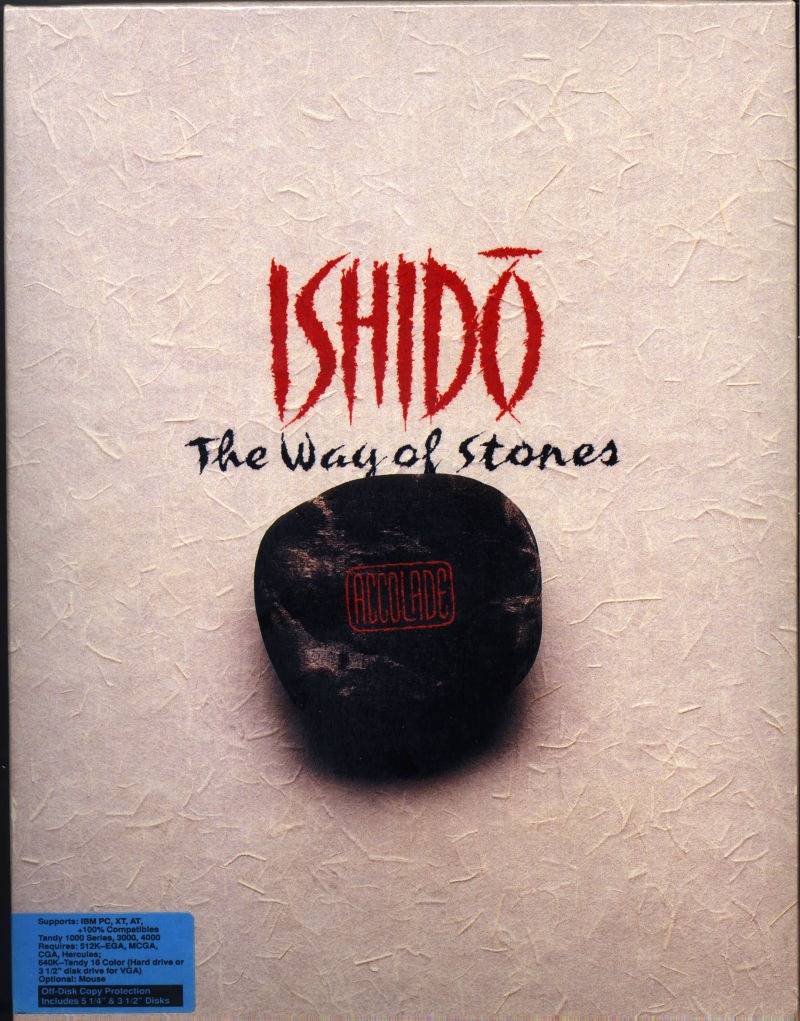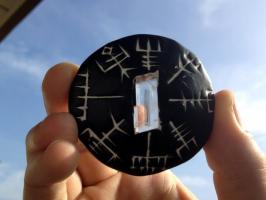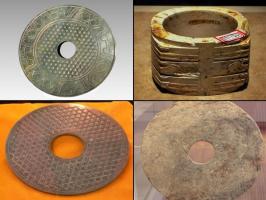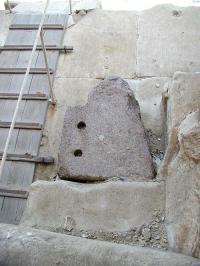Ishido - The Way of Stones


Ishido - The Way of Stones
by Accolade
Controls
You may use either the keyboard or the mouse
With keyboard:
- Press ESCAPE to display the menu bar.
- Use the LEFT & RIGHT ARROW KEYS to move from menu to menu; each drops down to display all the available commands.
- Use the UP & DOWN ARROWS to scroll among the commands on the current menu.
- Press ENTER to select the command that is highlighted.
- Press ESCAPE to leave the menu bar without selecting a command.
- When a dialog appears, use the ARROW KEYS to move the highlight around the dialog to the various options. When the desired option is highlighted, press ENTER to select the option.
- To place stones on the game board, use the ARROW KEYS to move the pointer from square to square. When the pointer is on the desired square, press ENTER to place the stone in that square (only if the move is allowed; see rules of play)
With mouse:
- Press the RIGHT MOUSE BUTTON to display the menu bar.
- Point to a menu and it drops down to reveal the available commands.
- Point to the command desired to highlight it.
- Press the LEFT MOUSE BUTTON to activate the highlighted command.
- Press the RIGHT MOUSE BUTTON at any time to leave the menu bar without selecting a command.
Summary:
Ishido is a game where you attempt to match stones according to their colors and patterns. Ishido can be played as a solitaire game, by two players, by a player against the computer, or even by the computer itself (this is useful to see how the computer thinks). You can also play cooperatively to achieve a high score, or competitively. Ishido has several unique features: You may consult the Oracle during the game to answer questions, and you can select from several different boards and stonesets, or even create your own stoneset.
The Game Board:
- The menu bar appears when you press ESCAPE or the RIGHT MOUSE BUTTON, and consists of the following menus: Yin-Yang symbol, File, Game, Options, Help, and High Scores.
- The Game Board is eight squares high by 12 squares wide.
- Stones come in sets of 72 stones. Every stone has two attributes: a color and a symbol. There are six symbols and six colors in each stoneset, thus creating 36 unique stones. Each stone comes in a pair, hence 72 stones in each stoneset.
- The Within consists of the light interior squares.
- The Beyond consists of the dark squares at the outer edges of the board.
- The Touchstone displays the next stone to be played.
- The Scoreboard shows both the number of points scored (at the top), and the number of 4-Way matches achieved (at the bottom). The Pouch shows a representation of the number of stones remaining to play. Clicking on it (or selecting Show Pouch from the Help menu) shows you the stones in detail, and their order in the pouch.
Four Simple Rules
- To create a 1-Way match you must match your stone with the stone on the board using one of your stones' two attributes.
- To create a 2-Way match you must match your stone using one of its attributes for one stone, and its other attribute for the other stone. (Remember: "1 and 1")
- To create a 3-Way match you must match your stone using one of its attributes for one stone, and its other attribute for the other two stones. (Remember: "1 and 2")
- To create a 4-Way match you must match your stone using one of its attributes for two of the stones, and its other attribute for the other two stones. (Remember: "2 and 2")
Ancient and Modern Ways of Playing
The Ancient Way: Game and Scoring
In the Ancient Way of playing Ishido, the player wins when he or she empties the pouch, placing all the stones on the board. The player also creates as many 4-Ways as possible.
The number of 4-Ways created appears on the lower portion of the scoreboard, next to the graphic for 4-Way symbol.
In Tournament and Challenge games, if several players empty the pouch, the player with the most 4-Ways wins. If no one empties the pouch, the player with the most 4-Ways wins. If no one empties the pouch and everyone has the same number of 4-Ways, the player with the fewest number of stones left in the pouch wins.
The Modern Way: Game and Scoring
In the Modern Way of playing, the goal is to score the highest number of points. Players can get high scores by creating as many 4-Ways as possible, as early in the game, as they try to empty to pouch.
Players receive points by legally placing stones next to other stones in the light, interior portion of the board (The Within). The greater the number of sides legally matched, the greater the number of points earned.
Points earned for legal matches are:
Single-sided match - 1 point
Two-sided match - 2 points
Three-sided match - 4 points
Four-sided match (4-Way) - 8 points
Each 4-Way match earns bonus points and doubles the points awarded for subsequent matches. For example, after the first 4-Way, a single-sided match earns two points, a two- sided match earns four points, a three sided-match earns eight points, and a 4-Way earns 16 points. The next 4-Way doubles the point scheme again, and so on.
Bonuses awarded after each 4-Way match are:
First 4-Way - 25 points
Second 4-Way - 50 points
Third 4-Way - 100 points
Fourth 4-Way - 200 points
Fifth 4-Way - 400 points
Sixth 4-Way - 600 points
Seventh 4-Way - 800 points
Eighth 4-Way - 1,000 points
Ninth 4-Way - 5,000 points
Tenth 4-Way - 10,000 points
Eleventh 4-Way - 25,000 points
Twelfth 4-Way - 50,000 points
At the end of the game, bonuses are awarded when fewer than three stones remain in the pouch. Bonuses are not awarded in the Challenge Game. Bonuses awarded are:
Two stones left in pouch - 100 points
One stone left in pouch - 500 points
Empty pouch - 1,000 points
The Stoneset Editor:
This allows you to modify or create stonesets to your liking. Basically, it should be fairly obvious. However, if you want to modify a stoneset with Deluxe Paint, you must use STONECVT.EXE. Load it, and then you can either convert a stoneset saved in Ishido format to .LBM (Deluxe Paint) or vice-versa.
These docs have been completely typed and assembled by the Rappin' Duke. Any questions regarding the game can be directed towards me. Any L.S.D. "netted" board will do.



























